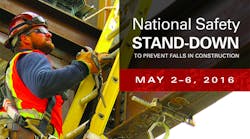OSHA is planning a 2016 Step-Up for Safety in the Upstream Oil and Gas Industry to raise awareness among employers and workers about hazards in oil and gas exploration. During step-up events, employers around the country are asked to take time out to conduct site inspections, safety training and other activities. These events will be held mid-February until the end of March.
“Hazardous working conditions are taking the lives of a growing number of workers employed in oil and gas extraction,” said Assistant Secretary of Labor for Occupational Safety and Health Dr. David Michaels. “This safety step-up will help emphasize the tremendous value in dedicating time during a workday to improve safety and health.”
The Step-Up is an activity of the alliance between OSHA; the National Service, Transmission, Exploration & Production Safety (STEPS) Network; and NIOSH. A total of 22 regional STEPS Networks will coordinate and promote the events.
The National STEPS Network, founded in 2003, is a volunteer organization that includes industry operators, contractors and associations, OSHA and NIOSH representatives, and educational institutions that promote safety, health, and environmental improvement in oil and gas exploration and production in U.S. onshore operations.
For more information, visit the Step Up for Safety Web site, which includes a menu of resources that employers can use during their events.
The National Safety Stand-Down Focuses on Falls
Falls are a leading cause of worker death and serious injury in the construction industry, and OSHA has designated May 2-6 as the National Safety Stand-Down. The event is a nationwide effort to remind and educate employers and workers in the construction industry of the serious dangers of falls - the cause of the highest number of industry deaths in the construction industry.
OSHA, NIOSH and the Center for Construction Research and Training are leading the effort to encourage employers to pause during their workday for topic discussions, demonstrations, and training on how to recognize hazards and prevent falls.
“Falls still kill far too many construction workers,” said Dr. David Michaels, Assistant Secretary of Labor for Occupational Safety and Health. “While we regularly work with employers, industry groups and worker organizations on preventing falls and saving lives, the National Safety Stand-Down encourages all employers – from small businesses to large companies operating at many job sites – to be part of our effort to ensure every worker makes it to the end of their shift safely.”
More than 4 million workers participated in the National Safety Stand-Downs in 2014 and 2015, and OSHA expects thousands of employers across the nation to join the 2016 event. To guide their efforts, OSHA has developed the official National Safety Stand-Down web site with information on conducting a successful stand-down. After their events, employers are encouraged to provide feedback and will receive a personalized certificate of participation.
“In many workplaces, falls are a real and persistent hazard. Given the nature of the work, the construction industry sees the highest frequency of fall-related deaths and serious, sometimes debilitating injuries,” said Dr. John Howard, director of NIOSH. “Since the effort began in 2014, the National Safety Stand-Down serves as an important opportunity for both employers and workers to stop and take time in the workday to identify existing fall hazards, and then offer demonstrations and training to emphasize how to stay safe on the job.”
The National Safety Stand-Down in 2016 is part of OSHA’s ongoing Fall Prevention Campaign. Begun in 2012, the campaign was developed in partnership with the NIOSH National Occupational Research Agenda program. It provides employers with lifesaving information and educational materials on how to take steps to prevent falls, provide the right equipment for their workers, and train all employees in the proper use of that equipment. OSHA has also produced a brief video with more information about the 2016 Stand-Down in English and Spanish.
For more information on the success of last year’s Stand-Down, see the final data report. To learn how to partner with OSHA in this Stand-Down, visit http://www.osha.gov/StopFallsStandDown/. The page provides details on how to conduct a stand-down; receive a certificate of participation; and access free education and training resources, fact sheets and other outreach materials in English and Spanish. To learn more about preventing falls in construction visit http://www.osha.gov/stopfalls/.

